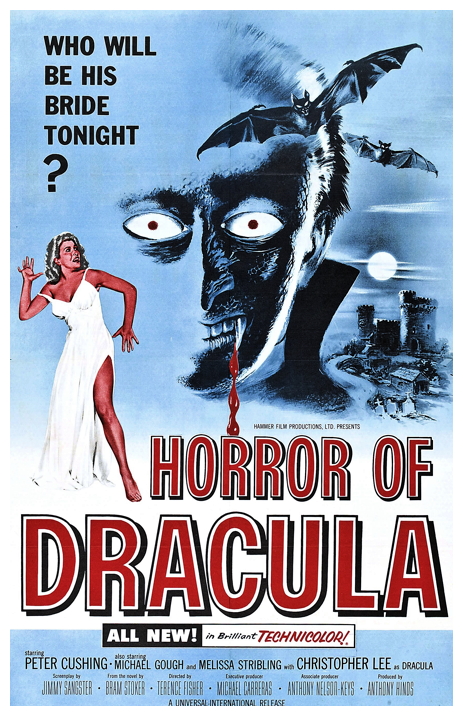 When I asked Horror News readers and Facebook friends to tell me their favourite vampire films, I received a terrific response. The suggestions poured in, and all kinds of weird, wonderful and outlandish films fronted up for selection. So while I can’t deny the quality or appeal of films like Planet Of The Vampires (1965), Count Yorga Vampire (1970), Vampyres (1974) or Shadow Of The Vampire (2000), I can only count it down to thirty.
When I asked Horror News readers and Facebook friends to tell me their favourite vampire films, I received a terrific response. The suggestions poured in, and all kinds of weird, wonderful and outlandish films fronted up for selection. So while I can’t deny the quality or appeal of films like Planet Of The Vampires (1965), Count Yorga Vampire (1970), Vampyres (1974) or Shadow Of The Vampire (2000), I can only count it down to thirty.
But what a list it is, celebrating some of the best and most original films in vampire cinema history, from the deeply gothic Dracula (1930) to the salacious kink of The Vampire Lovers (1970) to the comedic timings of Johnny Depp in Dark Shadows (2012). I wish to thank Wikipedia profusely for assisting me in my research. Please read on and embrace some of the most unusual and delicious fang films that you’re ever likely to witness!
THE ADDICTION (1995): Student Kathleen Conklin (Lili Taylor) succumbs to the bloodlust and a lot of spiritual guff in Abel Ferrara‘s ambitious but pretentious morality play. Is her addiction to blood, or to evil? Also starring Edie Falco, Paul Calderon and Christopher Walken, The Addiction was written by Ferrara’s regular screenwriter, Nicholas St. John, filmed in black-and-white and released simultaneously with Ferrara’s period gangster film The Funeral (1995).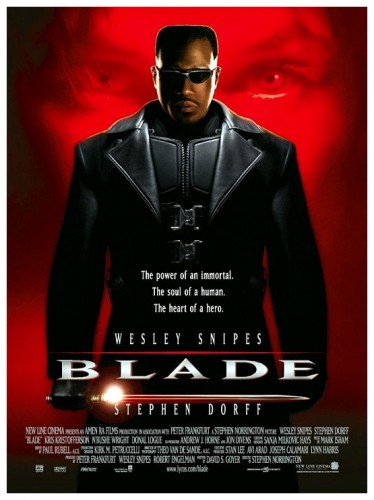
BLACULA (1972): Inevitably the Vampire film collided with the funky afroed world of Blaxploitation in this fabulously-titled genre hybrid. After denying Count Dracula pleasures with his wife, an African prince named Manuwalde (William Marshall) is bitten by the enraged Count. “You will be…Blacula!”
Revived some two hundreds years later in Los Angeles, Blacula begins a tortured search to be hip and to find his reincarnated wife. While many baby-boomers treasure fond memories of this absurd flick’s terrifying impact on them when younger, the scariest thing about Blacula today is the sight of black folk dancing without rhythm! Scream Blacula Scream! (1973) was the inferior sequel.
BLADE (1998): “The power of an immortal, the soul of a human, the heart of a hero,” Blade (Wesley Snipes) is what is known as a ‘Daywalker’ who moves between light and darkness in his quest to vanquish vampire scum.
Also starring Stephen Dorff and Kris Kristofferson, and loosely based upon the Marvel Comics character of the same name, Blade was directed by Stephen Norrington and written by David Goyer. Despite mixed reviews, Blade grossed US$131.2 million worldwide and was followed by Blade II (2002) and Blade Trinity (2004).
BLOOD FOR DRACULA (1973): Following Andy Warhol‘s Flesh For Frankenstein (1973), Blood For Dracula was a mildly p*rnographic vampire parody starring Udo Kier as Dracula, who is in terrible trouble because he needs the blood of virgins (pronounced ‘wirgins’) and there aren’t any left locally. He travels by limousine to Italy, where he moves in with a decadent aristocratic family – they hope to marry off one of their many daughters – and attempts to vampirise the sisters, one-by-one, having been assured that they’re all virgins. Thanks to the heroic efforts of the stud gardener (Joe Dallesandro), he is mistaken.
The polluted blood makes the Dracula frightfully sick – he acts as if he suffers terminal tuberculosis throughout the film – and there are extremely long scenes of him vomiting violently. There is also a very bloody finale, so extreme it resembles a scene from Monty Python And The Holy Grail (1975), in which the gardener chops off Dracula’s arms, legs and head. In between the moments of nausea and sexual couplings, there are many tedious moments, despite the implausible cameo role played by Vittoria De Sica.
BRAM STOKER’S DRACULA (1992): Serial rogue Gary Oldman can count (pun intended) his sincere performance in Bram Stoker’s Dracula as a career highlight but, when cast opposite Keanu Reeves and Winona Ryder, well, you’re going to look good anyway. Directed and produced by Francis Ford Coppola, the film also stars Anthony Hopkins and Sadie Frost. Also known simply as Dracula, it was greeted by a generally positive critical reception and was considered a success at the box-office so a follow-up, Mary Shelley’s Frankenstein (1994), was produced by Coppola and directed by Kenneth Branagh.
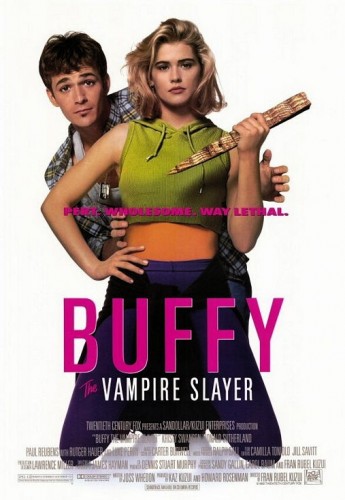 BUFFY THE VAMPIRE SLAYER (1992): “In every generation there is a chosen one. She alone will stand against the vampires, the demons and the forces of darkness. She is The Slayer.” A Southern Californian ‘Valley Girl’ cheerleader named Buffy Summers (Kristy Swanson) learns that it is her fate to hunt vampires. Also starring Donald Sutherland, Paul Reubens, Rutger Hauer and Luke Perry, it was a moderate success at the box office but received a mixed reception from critics. Nevertheless the film eventually become a cult favourite among fans, so writer Joss Whedon later created an acclaimed and somewhat darker television series of the same name.
BUFFY THE VAMPIRE SLAYER (1992): “In every generation there is a chosen one. She alone will stand against the vampires, the demons and the forces of darkness. She is The Slayer.” A Southern Californian ‘Valley Girl’ cheerleader named Buffy Summers (Kristy Swanson) learns that it is her fate to hunt vampires. Also starring Donald Sutherland, Paul Reubens, Rutger Hauer and Luke Perry, it was a moderate success at the box office but received a mixed reception from critics. Nevertheless the film eventually become a cult favourite among fans, so writer Joss Whedon later created an acclaimed and somewhat darker television series of the same name.
 CRONOS (1992): An elderly antiques dealer discovers a mysterious mechanised gadget hidden in the statue of an archangel. The former property of a sixteenth century alchemist and now coveted by a dying billionaire, the golden scarab-like device has a nasty habit of siphoning the blood of its owner, granting eternal life in return…but at what cost? A fatalistic rumination on the price of immortality and a ripping vampire flick to boot, Mexican director Guillermo Del Toro‘s classy debut feature film oozes atmosphere and inventively subverts established vampire lore, making him the perfect man for the job on Blade II (1992).
CRONOS (1992): An elderly antiques dealer discovers a mysterious mechanised gadget hidden in the statue of an archangel. The former property of a sixteenth century alchemist and now coveted by a dying billionaire, the golden scarab-like device has a nasty habit of siphoning the blood of its owner, granting eternal life in return…but at what cost? A fatalistic rumination on the price of immortality and a ripping vampire flick to boot, Mexican director Guillermo Del Toro‘s classy debut feature film oozes atmosphere and inventively subverts established vampire lore, making him the perfect man for the job on Blade II (1992).
DARK SHADOWS (2012): Inspired by the television soap opera of the late sixties, this tongue-in-cheek comedy is directed by Tim Burton and stars Johnny Depp as Barnabas Collins, a two-hundred-year-old vampire, and Michelle Pfeiffer as his cousin Elizabeth Collins Stoddard, the reclusive matriarch of the Collins family. In 1752, the Collins family sailed from Liverpool, England to North America and their son, Barnabas, grows up to be a wealthy playboy and the master of Collinwood Manor. He breaks the heart of a witch, Angelique Bouchard, who turns him into a vampire and buries him alive. In 1972, Barnabas is accidentally freed from his coffin and returns to find his once-magnificent mansion now in ruin. The manor is currently occupied by Barnabas’ dysfunctional descendants, all of whom are hiding dark and horrifying secrets.
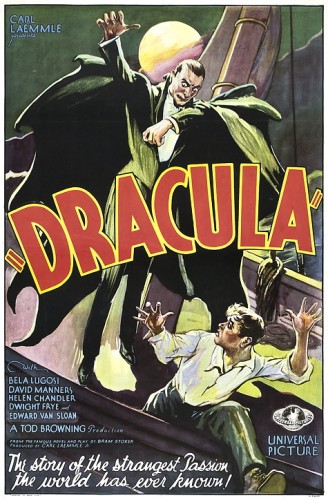 DRACULA (1930): Dracula was originally intended as a vehicle for Lon Chaney Senior, who sadly passed away, so Universal turned to the relatively unknown Bela Lugosi, who was very familiar with the role following a two-year stint in the stage production. This opportunity for the Hungarian actor would not only change his life, but would forever associate Lugosi with Dracula (and later Ed Wood). Although no-where near as chilling as the silent Nosferatu (1922) which remains an unparalleled masterpiece, the 1930 version introduced the accent and the look that has become common practice. A frenzied Renfield (Dwight Frye) and some wonderful camera work from Carl Freund also deserve kudos. Fangs for the memories.
DRACULA (1930): Dracula was originally intended as a vehicle for Lon Chaney Senior, who sadly passed away, so Universal turned to the relatively unknown Bela Lugosi, who was very familiar with the role following a two-year stint in the stage production. This opportunity for the Hungarian actor would not only change his life, but would forever associate Lugosi with Dracula (and later Ed Wood). Although no-where near as chilling as the silent Nosferatu (1922) which remains an unparalleled masterpiece, the 1930 version introduced the accent and the look that has become common practice. A frenzied Renfield (Dwight Frye) and some wonderful camera work from Carl Freund also deserve kudos. Fangs for the memories.
DRACULA (1958): Towards the close of the decade it was apparent that science fiction was running out of steam as the sole basis for fantastic films and producers started to bring back horror. This was further underlined with the success of The Curse Of Frankenstein (1957) produced in England by Hammer. Hammer, Peter Cushing and Christopher Lee were hot-to-trot and, to further exploit this success, they regrouped for Dracula also known as Horror Of Dracula, a vibrant retelling of the Bram Stoker classic decked out with lavish (if low budget) production values, a compelling performance by Lee as the vampire count, and workmanlike uncluttered direction from Terence Fisher. Once more the emphasis was on physical grue and violence though, by today’s standards, this early Hammer horror seems rather tame. But for the time, the formula worked marvelously, and for nearly two decades the studio produced a series of features which, for the most part, proved popular with international audiences.
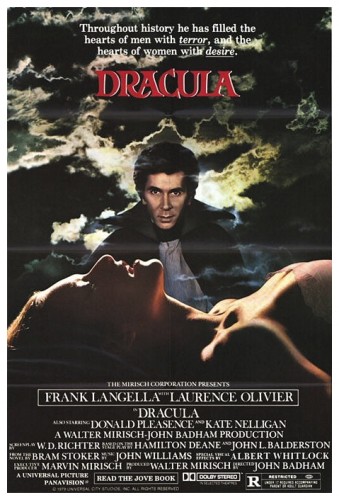 DRACULA (1979): It was a big year for vampires. At the intellectual end of the spectrum was a German film directed by Werner Herzog, Nosferatu The Vampyre (1979), a beautiful dream-like remake of Nosferatu (1922). On television was the two-part miniseries Salem’s Lot (1979) based on the bestselling novel by Stephen King. At the Hollywood end of the spectrum, Universal Studios attempted to reboot their romantic horror franchise with a lavish retelling of Bram Stoker‘s classic Dracula starring a young Frank Langella making a convincing vampire, all urbane wit, charm and well-mannered sexiness when at ease, a ferocious beast when aroused. He’s easily the best thing in director John Badham‘s lavish but rather laborious remake of Dracula (1930). Like Bela Lugosi, the swarthy Langella first played the role on stage, going from Broadway to Badham to boney Skeletor in Masters Of The Universe (1987) in eight short years.
DRACULA (1979): It was a big year for vampires. At the intellectual end of the spectrum was a German film directed by Werner Herzog, Nosferatu The Vampyre (1979), a beautiful dream-like remake of Nosferatu (1922). On television was the two-part miniseries Salem’s Lot (1979) based on the bestselling novel by Stephen King. At the Hollywood end of the spectrum, Universal Studios attempted to reboot their romantic horror franchise with a lavish retelling of Bram Stoker‘s classic Dracula starring a young Frank Langella making a convincing vampire, all urbane wit, charm and well-mannered sexiness when at ease, a ferocious beast when aroused. He’s easily the best thing in director John Badham‘s lavish but rather laborious remake of Dracula (1930). Like Bela Lugosi, the swarthy Langella first played the role on stage, going from Broadway to Badham to boney Skeletor in Masters Of The Universe (1987) in eight short years.
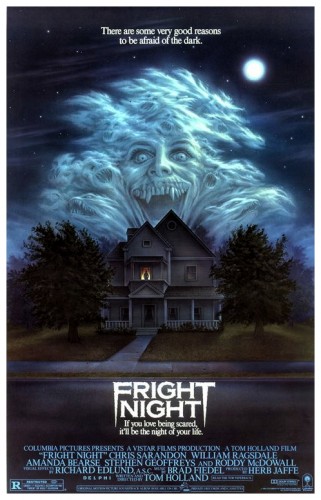 FRIGHT NIGHT (1985): “Back, spawn of Satan!” Peter Vincent (Roddy McDowall) is a has-been horror movie host and former Hollywood vampire killer who is reluctantly employed by a paranoid teenager (William Ragsdale) who is convinced that his new neighbour (Chris Sarandon) is a bloodsucker. Written and directed by Tom Holland and produced by Herb Jaffe, the film was followed by a sequel imaginatively titled Fright Night II (1988) and a rather loose 3-D remake in 2011.
FRIGHT NIGHT (1985): “Back, spawn of Satan!” Peter Vincent (Roddy McDowall) is a has-been horror movie host and former Hollywood vampire killer who is reluctantly employed by a paranoid teenager (William Ragsdale) who is convinced that his new neighbour (Chris Sarandon) is a bloodsucker. Written and directed by Tom Holland and produced by Herb Jaffe, the film was followed by a sequel imaginatively titled Fright Night II (1988) and a rather loose 3-D remake in 2011.
FROM DUSK TILL DAWN (1992): Writer Quentin Tarantino‘s years as a video store geek pay off big-time in this totally troppo pastiche of classic grindhouse VHS shockers, shot from the hip by up-and-coming filmmaker Robert Rodriguez. This post-drive-in salute to salsa splatter cunningly masquerades as an edgy crime thriller for its first half until George Clooney, Harvey Keitel and company hit the Titty-Twister, an Aztec vampire nest disguised as a sleazy south-of-the-border stripperama. Simultaneously exploiting, lampooning and reinventing all the requisite vampire cliches, this consistently gobsmacking gem is pure B-movie heaven. Few screen vamps are as voluptuous as Salma Hayek’s sultry Satanico Pandemonium. Followed by two direct-to-video sequels, Texas Blood Money (1999) and The Hangman’s Daughter (2000), both of which pale in comparison.
THE HUNGER (1983): The directorial debut of Tony Scott is the story of a love triangle between a doctor (Susan Sarandon) who specialises in aging research and a vampire couple (Catherine Deneuve and David Bowie). The screenplay by Ivan Davis and Michael Thomas is a loose adaptation of the Whitley Strieber novel, with absolutely beautiful cinematography by Stephen Goldblatt, and proved popular when it screened out of competition at the 1983 Cannes Film Festival. As immortal beauty Miriam Blaylock, Deneuve’s soft-focus lesbian romp with Sarandon made much more sense than her desire for a rapidly withering David Bowie.
INNOCENT BLOOD: Craving Italian food, sexy French vampire Marie (Anne Parillaud) snacks on gangster Sal ‘The Shark’ Macelli (Robert Loggia) only to inadvertently create a new breed of bloodsucking mob boss. Packed to the gills with energetic action sequences, nudity, outrageous special effects, cameos galore and most of The Sopranos cast, director John Landis‘ rambunctious mix of monsters and mobsters is an undiscovered gem ripe for reappraisal. This is probably the only time you’ll ever get to see the great Don Rickles disintegrate, which has got to be recommendation enough. Unfortunately, a cut version was released in Australia and other countries as A French Vampire In New York in order to capitalise on the director’s earlier hit An American Werewolf In London (1981).
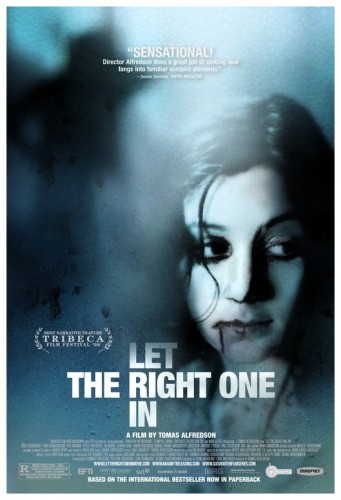 LET THE RIGHT ONE IN (2008): Known in its original Swedish as Låt Den Rätte Komma In, Let The Right One In was directed by Tomas Alfredson and written by John Ajvide Lindqvist basing the screenplay on his own novel. The film tells the story of a bullied twelve-year-old boy who develops a friendship with a young-looking vampire girl in Blackeberg, a suburb of Stockholm, during the early eighties. Alfredson, unconcerned with the horror and vampire conventions, decided to tone down many elements of the novel and focus primarily on the relationship between the two main characters. The film received widespread international critical acclaim and won many awards, including the Founders Award for Best Narrative Feature at the Tribeca Film Festival and Best Film at the European Fantastic Film Festival Federation, as well as four Guldbagge Awards from the Swedish Film Institute and the Saturn Award for Best International Film.
LET THE RIGHT ONE IN (2008): Known in its original Swedish as Låt Den Rätte Komma In, Let The Right One In was directed by Tomas Alfredson and written by John Ajvide Lindqvist basing the screenplay on his own novel. The film tells the story of a bullied twelve-year-old boy who develops a friendship with a young-looking vampire girl in Blackeberg, a suburb of Stockholm, during the early eighties. Alfredson, unconcerned with the horror and vampire conventions, decided to tone down many elements of the novel and focus primarily on the relationship between the two main characters. The film received widespread international critical acclaim and won many awards, including the Founders Award for Best Narrative Feature at the Tribeca Film Festival and Best Film at the European Fantastic Film Festival Federation, as well as four Guldbagge Awards from the Swedish Film Institute and the Saturn Award for Best International Film.
LIFEFORCE (1985): While investigating Halley’s Comet, the crew of the space shuttle Churchill finds a 150-mile long spaceship hidden in the corona of the comet. Upon entering the alien spacecraft, the crew discovers hundreds of dead and shrivelled bat-like creatures and three naked humanoid bodies (two male and one female) in suspended animation within glass coffin-like containers. The crew recovers the three aliens and begins the return trip to Earth and its potential doom. Scripted by Dan O’Bannon, Tobe Hooper‘s wacky film adaptation of the Colin Wilson novel The Space Vampires has a trio of alien vamps gorging themselves on human life energy, trashing London and wandering about town stark naked! Hurly burly! Despite the nudity, the film on the whole feels like an homage to the works of English screenwriter Nigel Kneale, creator of the Quatermass television serials.
 THE LOST BOYS (1987): Despite the dubious honour of launching Kiefer Sutherland‘s long career (and Bill Winter‘s fleeting career), Joel Schumacher‘s hip and sexy teen vampire comedy remains a lively eighties time capsule of peroxide mullet haircuts, New Romantic fashions, slick MTV-style visuals and, of course, the two Coreys: Corey Feldman and the late Corey Haim. When Jason Patric gets inducted into the so-called ‘bloodsucking Brady Bunch’ his trendy younger brother goes on the defensive with holy water pistols, garlic baths and the obligatory rock soundtrack. The film may be considered too flippant for hardcore vampire purists, but it’s a safer bet than Jim Carrey‘s Once Bitten (1985), and is a guilty pleasure by any other name.
THE LOST BOYS (1987): Despite the dubious honour of launching Kiefer Sutherland‘s long career (and Bill Winter‘s fleeting career), Joel Schumacher‘s hip and sexy teen vampire comedy remains a lively eighties time capsule of peroxide mullet haircuts, New Romantic fashions, slick MTV-style visuals and, of course, the two Coreys: Corey Feldman and the late Corey Haim. When Jason Patric gets inducted into the so-called ‘bloodsucking Brady Bunch’ his trendy younger brother goes on the defensive with holy water pistols, garlic baths and the obligatory rock soundtrack. The film may be considered too flippant for hardcore vampire purists, but it’s a safer bet than Jim Carrey‘s Once Bitten (1985), and is a guilty pleasure by any other name.
LOVE AT FIRST BITE (1979): Written by Robert Kaufman, director Stan Dragoti‘s send-up of Dracula lore featured great comic performances from George Hamilton as the love-smitten sun-tanned Count Dracula and Arte Johnson as an aging, gleefully demented Renfield, but some of the ethnic jokes were uncomfortable even back then, and they are outright painful today. Also starring Susan Saint James and Richard Benjamin, the music is composed by Charles Bernstein and the disco-dancing Count shakes his booty to I Love The Nightlife by Gloria Gaynor.LUST FOR A VAMPIRE (1971): Directed by Jimmy Sangster and starring Yutte Stensgaard, Michael Johnston and Barbara Jefford, Lust For A Vampire is the second film in the so-called Karnstein trilogy, loosely based on the J. Sheridan Le Fanu novella Carmilla. The first film was The Vampire Lovers (1970), the third was Twins Of Evil (1971). The three films aren’t actually chronological but simply use the Karnstein family as the source of the vampiric threat. This is Hammer Studio’s most titillating outing as lesbian vampire Carmilla Karnstein (Yutte Stensgaard) teaches a nineteenth century girls finishing school more about tits and arse than they’d ever learn in class. The film has a cult following although some Hammermaniacs accuse it of being too camp and downright silly. Also starring Ralph Bates, David Healey, Mike Raven, and Harvey Hall, who has a different role in each film of this series.
MARTIN (1978): Having brought some respectability to the living dead, director George Romero brings his distinctive mix of splatter and social subtext to the tale of Martin (John Amplas), a disturbed Pennsylvania youth who believes himself to be an 84-year-old vampire. But is he? This is the central dilemma that drives Romero’s insightful and sympathetic portrait. Lacking the conventional fangs, the bloodthirsty teenager uses razor blades and syringes to get at the red stuff, reporting his nefarious exploits to a late-night talkback radio station while his old-world uncle becomes convinced that he really is Nosferatu. Offering a unique perspective on vampirism without the gothic trappings, Martin is often overlooked and vastly underrated.
NEAR DARK (1987): Naive cowboy Caleb Colton (Adrian Pasdar) finds himself abducted and inducted into a nomadic tribe of grungy immortal hellraisers who prowl the midwest after dark in search of blood. Director Kathryn Bigelow‘s first feature film is a startlingly effective combination of horror, western and road movie whose refusal to adhere to the conventions of vampire cinema ironically make it one of the finest entries in the genre. While the destructive power of sunlight and the hunger for blood remains consistent, the ‘V’ word is never mentioned and there’s even a reasonably easy cure for the condition. As in Bram Stoker‘s original novel, the condition can be cured with a blood transfusion, which was considered pretty high-tech stuff back when Dracula was published. Besides possessing a striking visual sense, Bigelow’s major coup is in the casting of Aliens (1986) actors Bill Paxton, Lance Henriksen and Jeanette Goldstein as the core of her ruthless vampire pack. An unmissable cult favourite fully deserving of its reputation.
 NOSFERATU (1922): The name itself is enough to induce an excrement hemorrhage in anyone who watched this movie during their youth, like I did when it was first released. I mean, those fingernails! He clearly isn’t getting regular manicures, and Nosferatu had the shaved-head look long before it was trendy. Overall, it’s one fine piece of cinema. The film stars the aptly named Max Schreck as the vampire. Schreck, in case you weren’t aware of it, is the German word meaning ‘fear’. How cool is that? Schreck was a Stanislovsky method actor, which meant that he immersed himself fully in the character – as well as the unconsecrated soil of Transylvania. He was so effective that some on the set of Nosferatu believed that Schreck might actually be a vampire. This conceit was later used in Shadow Of The Vampire (2000) starring John Malkovich as director F.W. Murnau and Willem Dafoe as Max Schreck, a vampire pretending to be an actor.
NOSFERATU (1922): The name itself is enough to induce an excrement hemorrhage in anyone who watched this movie during their youth, like I did when it was first released. I mean, those fingernails! He clearly isn’t getting regular manicures, and Nosferatu had the shaved-head look long before it was trendy. Overall, it’s one fine piece of cinema. The film stars the aptly named Max Schreck as the vampire. Schreck, in case you weren’t aware of it, is the German word meaning ‘fear’. How cool is that? Schreck was a Stanislovsky method actor, which meant that he immersed himself fully in the character – as well as the unconsecrated soil of Transylvania. He was so effective that some on the set of Nosferatu believed that Schreck might actually be a vampire. This conceit was later used in Shadow Of The Vampire (2000) starring John Malkovich as director F.W. Murnau and Willem Dafoe as Max Schreck, a vampire pretending to be an actor.
SALEM’S LOT (1979): Max Schreck‘s Nosferatu (1922) makeup appeared in quite a different vampire story, the two-part television miniseries Salem’s Lot based on the bestselling novel by Stephen King. Released theatrically outside the USA, the film’s running time was around 112 minutes but, if you insist on inflicting this somewhat dodgy adaptation upon yourself, I recommend you to seek out the complete 184 minute version, which should greatly enrich your perspective of the plot. Horror fans were eager to see this, for it was directed by Tobe Hooper of Texas Chainsaw Massacre (1973) fame, but the deadening propriety of television took its toll, and there isn’t much left that’s terribly disturbing. One or two television taboos are mildly contravened: Children are placed in jeopardy – there is an excellently creepy vampire, a small boy, who floats outside his brother’s bedroom window with a very nasty smile – and, in an entirely non-fantastic scene, a cuckolded man takes humiliating revenge on his wife’s lover. In fact, this is the most typically Hooper sequence – it has all the sordid sweatiness of real human fear, and it makes the vampire sequences look a bit hollow in comparison.
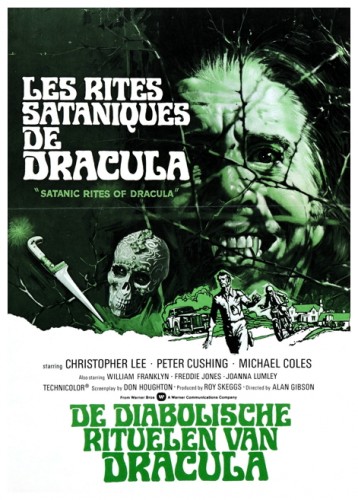 THE SATANIC RITES OF DRACULA (1973): Count Dracula may be immortal, but the sun was bound to rise on the long-running Hammer series of Dracula films starring Christopher Lee, the most recognisable incarnation of Count Dracula second only to Bela Lugosi. And sunrise came not a moment too soon, since this film is one of the most laughable attempts to update a horror character to the present day. So consider yourself warned: this film really sucks, but not the way a Dracula movie should. Also known by the more cumbersome title Count Dracula And His Vampire Bride, Satanic Rites transforms the ancient vampire into a scheming latter-day super-villain. He has henchmen who kill, kidnap and ride around on motorcycles, a mystical oriental women, deadly serums, colluding heads of industry, a future-retro control room, and even ex-Bond girl Joanna Lumley as fangbait. Perhaps this should have been called The Man With The Pointy Teeth. Come to think of it, with a basement full of brides that should be The Mormon With The Pointy Teeth. I wonder what the prenuptial agreement looked like?
THE SATANIC RITES OF DRACULA (1973): Count Dracula may be immortal, but the sun was bound to rise on the long-running Hammer series of Dracula films starring Christopher Lee, the most recognisable incarnation of Count Dracula second only to Bela Lugosi. And sunrise came not a moment too soon, since this film is one of the most laughable attempts to update a horror character to the present day. So consider yourself warned: this film really sucks, but not the way a Dracula movie should. Also known by the more cumbersome title Count Dracula And His Vampire Bride, Satanic Rites transforms the ancient vampire into a scheming latter-day super-villain. He has henchmen who kill, kidnap and ride around on motorcycles, a mystical oriental women, deadly serums, colluding heads of industry, a future-retro control room, and even ex-Bond girl Joanna Lumley as fangbait. Perhaps this should have been called The Man With The Pointy Teeth. Come to think of it, with a basement full of brides that should be The Mormon With The Pointy Teeth. I wonder what the prenuptial agreement looked like?
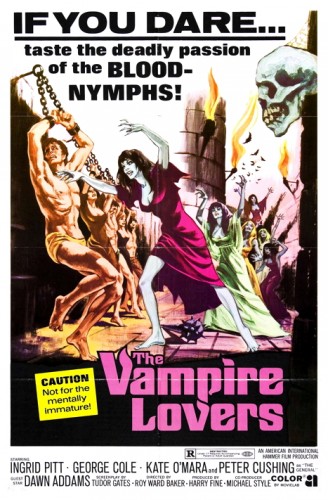 THE VAMPIRE LOVERS (1970): Sheridan Le Fanu‘s novel Carmilla gets the Hammer Horror treatment with Ingrid Pitt and Kate O’Mara directing the sappho traffic before being beheaded by a bemused Peter Cushing. Directed by Roy Ward Baker and also starring Madeline Smith and Jon Finch, the film is the first part of the so-called Karnstein Trilogy, followed by Lust For A Vampire (1971) and Twins Of Evil (1971). The three films were somewhat daring for the time in explicitly depicting lesbian vampire themes. In fact, before production began the script was sent to the censors, who warned the studio about depictions of lesbianism. Hammer Studios insisted that the lesbianism wasn’t their fault as it was actually present in the original story by Le Fanu. The censors backed down.
THE VAMPIRE LOVERS (1970): Sheridan Le Fanu‘s novel Carmilla gets the Hammer Horror treatment with Ingrid Pitt and Kate O’Mara directing the sappho traffic before being beheaded by a bemused Peter Cushing. Directed by Roy Ward Baker and also starring Madeline Smith and Jon Finch, the film is the first part of the so-called Karnstein Trilogy, followed by Lust For A Vampire (1971) and Twins Of Evil (1971). The three films were somewhat daring for the time in explicitly depicting lesbian vampire themes. In fact, before production began the script was sent to the censors, who warned the studio about depictions of lesbianism. Hammer Studios insisted that the lesbianism wasn’t their fault as it was actually present in the original story by Le Fanu. The censors backed down.
VAMPIRES (1998): By some astonishing rationale, John Carpenter fans and critics alike dismissed this sun-bleached and invigorating low-budget project from the director’s well-established scare factory. Based on the novel Vampire$ by John Steakley, a wisecracking vampire hunter (James Woods) is hired by the Vatican to exterminate the latest undead horseman of the apocalypse. Fittingly, the end of the world begins in Arizona, where Woods and his redneck crew experience one of the greatest motel bloodbaths ever filmed, Daniel Baldwin gets to beat up a blonde before suddenly falling hopelessly in love with his curvaceous punching bag, and a terrific slide-guitar soundtrack signposts the outrageous posturing of Woods’ interpretation of the modern-day Marlboro Man.
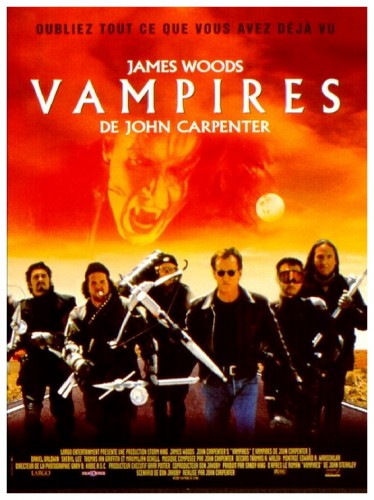 VAMPIRE’S KISS (1989): Peter Loew (Nicolas Cage) is a driven yuppie literary agent who is slowly and inexorably going insane. He plays the consummate businessman by day, and club hops by night, with little in his life of any importance but one-night-stands and the pursuit of money and prestige. He is eventually nipped by vampire Rachel (Jennifer Beals) and is soon eating bugs, wearing sunglasses, plastic fangs and tormenting his secretary. Intriguing meditation on madness, or lame horror comedy? You decide! It was written by Joseph Minion, who also scripted Martin Scorcese‘s darkly humorous film After Hours (1985) and co-stars Maria Conchita Alonso and Elizabeth Ashley.
VAMPIRE’S KISS (1989): Peter Loew (Nicolas Cage) is a driven yuppie literary agent who is slowly and inexorably going insane. He plays the consummate businessman by day, and club hops by night, with little in his life of any importance but one-night-stands and the pursuit of money and prestige. He is eventually nipped by vampire Rachel (Jennifer Beals) and is soon eating bugs, wearing sunglasses, plastic fangs and tormenting his secretary. Intriguing meditation on madness, or lame horror comedy? You decide! It was written by Joseph Minion, who also scripted Martin Scorcese‘s darkly humorous film After Hours (1985) and co-stars Maria Conchita Alonso and Elizabeth Ashley.
VAMPYR (1932): Directed by Carl Dreyer and inspired by J. Sheridan Le Fanu‘s collection of stories entitled In A Glass Darkly, Vampyr was funded by Nicolas de Gunzburg who starred in the film under the name of Julian West among a mostly non-professional cast. Gunzberg plays the role of Allan Grey, a student of the occult who enters the village of Courtempierre, which is under the curse of a vampire. Vampyr isn’t the easiest classic film to enjoy, even if you are a fan of vintage horror movies but, if you’re patient with the slow pacing and ambiguous story line, you’ll find that this film offers many striking images. The greatness of the film derives partly from its handling of the vampire theme in terms of sexuality and eroticism and partly from its highly distinctive dreamy look, but it also has something to do with Dreyer’s radical recasting of narrative form. A triumph of the irrational, this eerie effort never allows either protagonist or viewer to fully wake-up from its surreal nightmare.
ZOLTAN HOUND OF DRACULA (1978): When a military excavation in Romania unearths the tomb of Dracula they also unleash the Count’s favourite pooch – a glowing-eyed dog of indeterminate breed – and his cadaverous keeper (Reggie Nalder). Searching for a new master, Zoltan zeroes in on Dracula descendant Michael Drake (Michael Pataki) and a game of fetch-the-stake quickly ensues between the vampire mutt and Drake’s whitebread American family. Woof! Also known as Dracula’s Dog and featuring special makeup effects by a rookie named Stan Winston, Zoltan Hound Of Dracula is a risible but undeniably unusual genre mongrel that’s pure seventies drive-in fare. Foolish but kind-of fun…if you’ve consumed enough Absinthe, that is.
 Horror News | HNN Official Site | Horror Movies,Trailers, Reviews
Horror News | HNN Official Site | Horror Movies,Trailers, Reviews
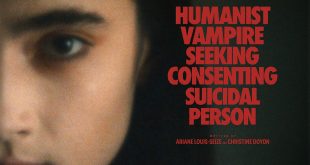
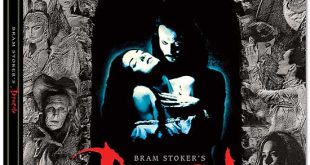
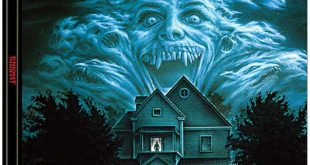
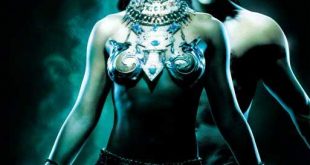

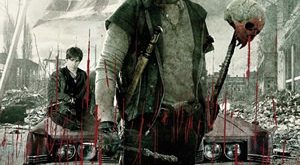
Love this list…. Really happy with most of it that’s on it.
Hello, good evening and welcome Josh!
I can’t thank you enough for your kind comments, and more thanks for simply reading! A list limited to twenty or thirty makes it a little easier than trying to compile a complete list, especially when one asks Facebook friends for their opinions. Some classics will be taken for granted, alongside bizarre cult favourites and some very unusual choices indeed.
For instance, I might not have included Lifeforce or, say, The Addiction without their suggestions being added. Unusual was the number of votes for the Karstein trilogy – part one The Vampire Lovers and part two Lust For A Vampire – as separate films. Which films might you have included/excluded? It’s at this point I’ll ask you to please join me next week when I burst your blood vessels with another terror-filled excursion to the dark side of Hollywood for…Horror News! Toodles!
Nigel.
awsome list / article – if we ever get all these reviewed, I’ll have to link them up ;)
im going to see dark shadows now. is any body else
nigel honey bone i watch you on youtube
your show is ok nigel i want to know are you british
blacula wow
blacula sounds racest and i love vanpires and i want to see it but im not racest